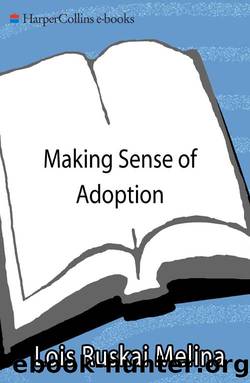Making Sense of Adoption by Lois Ruskai Melina

Author:Lois Ruskai Melina [Melina, Lois Ruskai]
Language: eng
Format: epub
ISBN: 978-0-062-03816-6
Publisher: HarperCollins
Published: 1989-01-15T00:00:00+00:00
Parents and social workers have found that a good way to help a child share his thoughts and feelings about adoption is to have him make a lifebook. Lifebooks are useful tools to help children organize their memories and make sense of how they joined their families. They traditionally have been used to help a child who has moved from one family to another several times understand his life history.
A lifebook is a chronicle of a childâs life. It is a story that begins with his birth, records special events and special people in his life, and provides a place to keep special memories and mementos.
To make a lifebook you will need a scrapbook, art supplies, and a time and place in which you and your child can work without being interrupted.
Youâll want your child to draw the illustrations and write the accompanying narrative, but youâll need to be close by to fill in the gaps in his memory and correct any misunderstandings he has.
Begin by asking your child what the first thing is that happened to him in his life. The obvious answer is that he was born, but if heâs adopted, he very well may reply, âI came to live with you.â In discussing his birth, talk about where he was born (city and state as well as specific location, such as a hospital) and the circumstances of his birth (who was there, what kind of birth it was, what time of day and day of the week).
An ideal time to discuss your childâs birthparents is when you ask your child to draw a picture of his birthparents and write down what he knows about them. If you have more information or an actual photograph, this may be a good time to introduce it. Help correct any inaccuracies in your childâs drawings or narratives by saying, for example, âYou made your birthmotherâs hair brown, but I remember that it was red.â Pay attention to the expressions on the birthparentsâ faces and ask your child why he thinks his birthmother was sad (or happy).
If you donât have information about your childâs birthparents, ask him to draw what he thinks they look like and describe what he thinks they are like. Encourage your child to be realistic by correcting any fantasies, for example: âI know you would like to think that your birthfather was a Nobel Prize winner. He was probably an intelligent man, because you are intelligent, but probably not a famous man. How can you show that heâs intelligent without making him a famous person?â
Continue to have your child record the significant events in his life, including his separation from his birthparent or birthparents and his entry into your family. Use the guidelines in this chapter for discussing unpleasant incidents such as abuse.
This is not the story of how your child joined your family, but the story of his life, so also include other significant events, such as starting school, achievements, a move to a new house, and the acquisition of a family pet.
Download
This site does not store any files on its server. We only index and link to content provided by other sites. Please contact the content providers to delete copyright contents if any and email us, we'll remove relevant links or contents immediately.
The Incest Diary by Anonymous(7526)
The Lost Art of Listening by Michael P. Nichols(7373)
The Rosie Project by Graeme Simsion(6139)
Beartown by Fredrik Backman(5563)
We Need to Talk by Celeste Headlee(5515)
Ego Is the Enemy by Ryan Holiday(5251)
Hunger by Roxane Gay(4846)
Suicide Notes by Michael Thomas Ford(4710)
I Love You But I Don't Trust You by Mira Kirshenbaum(3787)
Mummy Knew by Lisa James(3593)
Not a Diet Book by James Smith(3309)
Crazy Is My Superpower by A.J. Mendez Brooks(3285)
Girl, Wash Your Face by Rachel Hollis(3183)
Toxic Parents by Susan Forward(3178)
The Complete Idiot's Guide to Coping With Difficult People by Arlene Uhl(3103)
Name Book, The: Over 10,000 Names--Their Meanings, Origins, and Spiritual Significance by Astoria Dorothy(2918)
The Social Psychology of Inequality by Unknown(2914)
The Hard Questions by Susan Piver(2876)
The Gaslight Effect by Dr. Robin Stern(2716)
